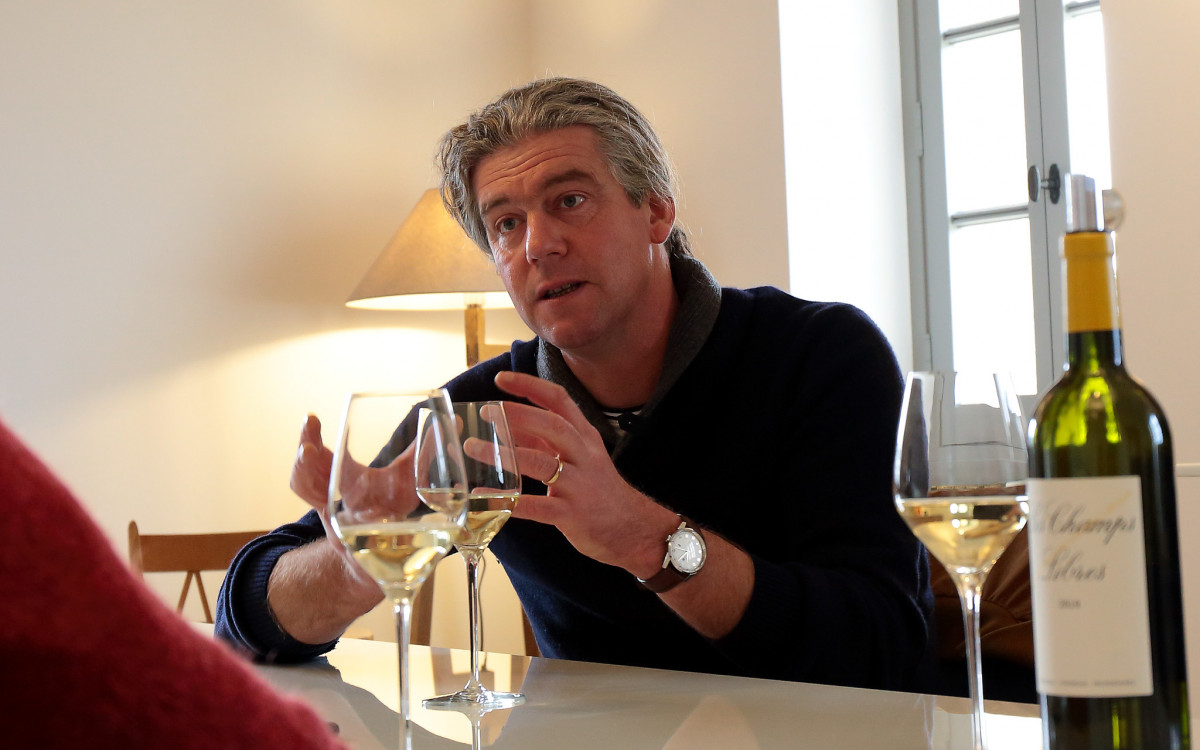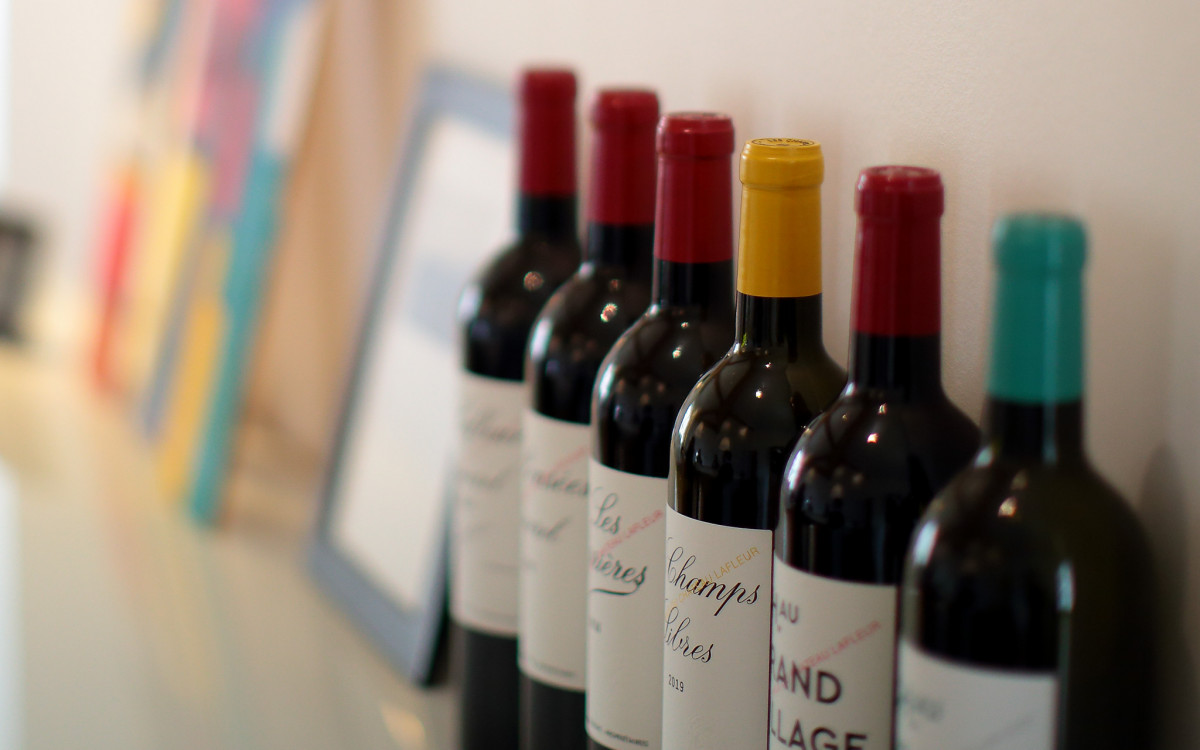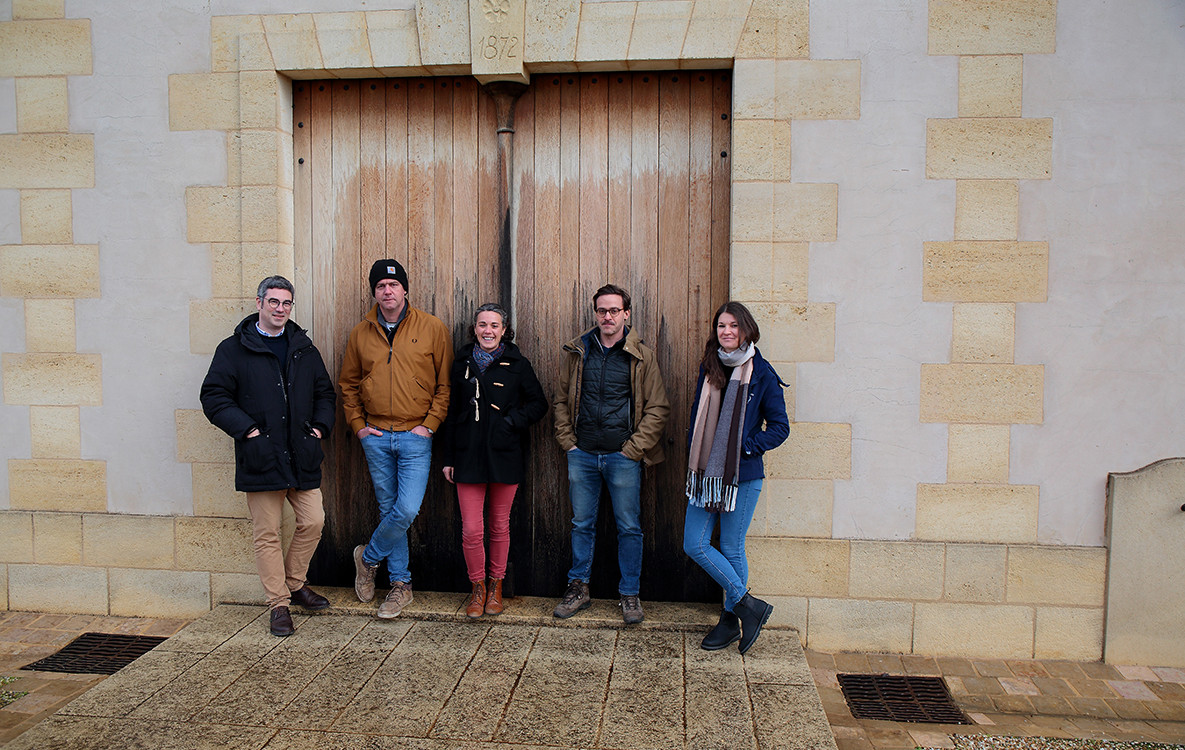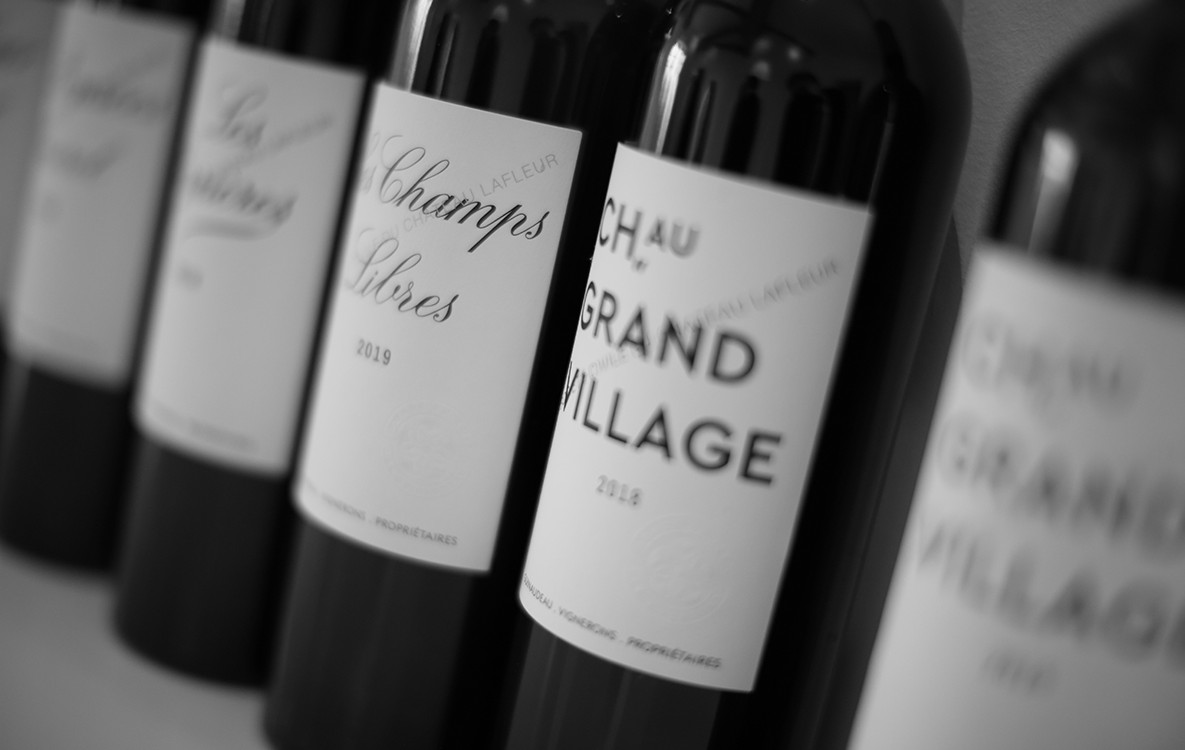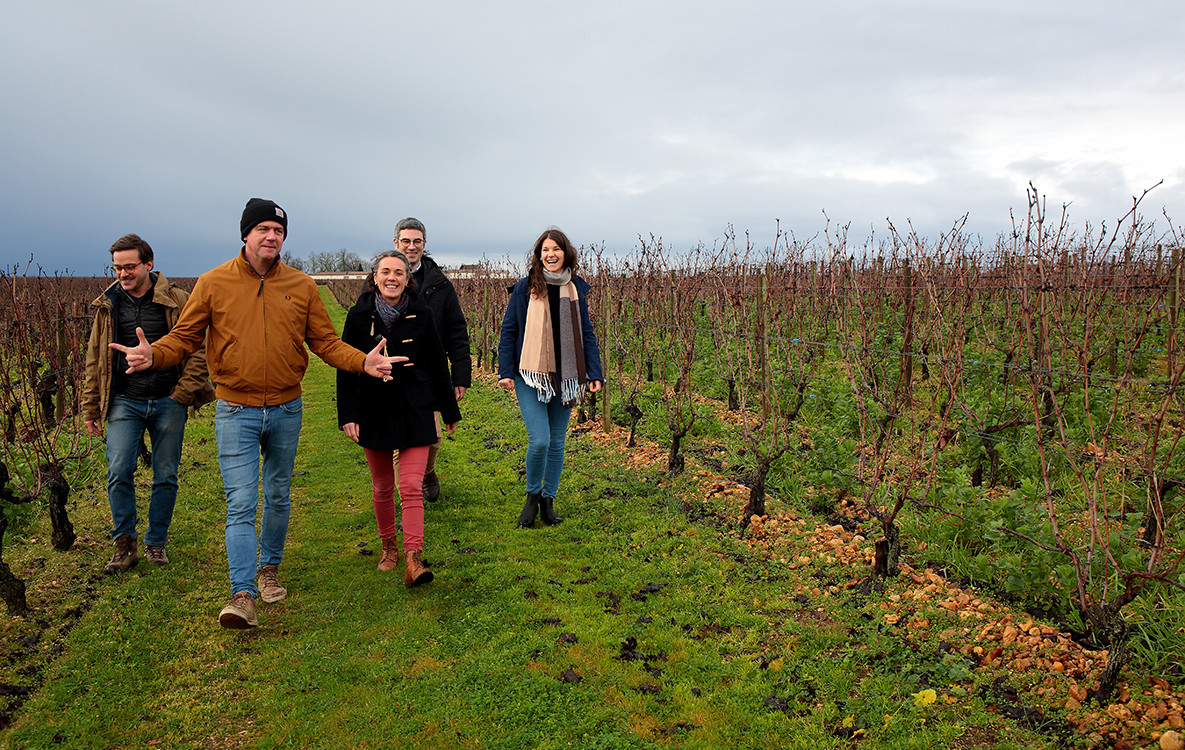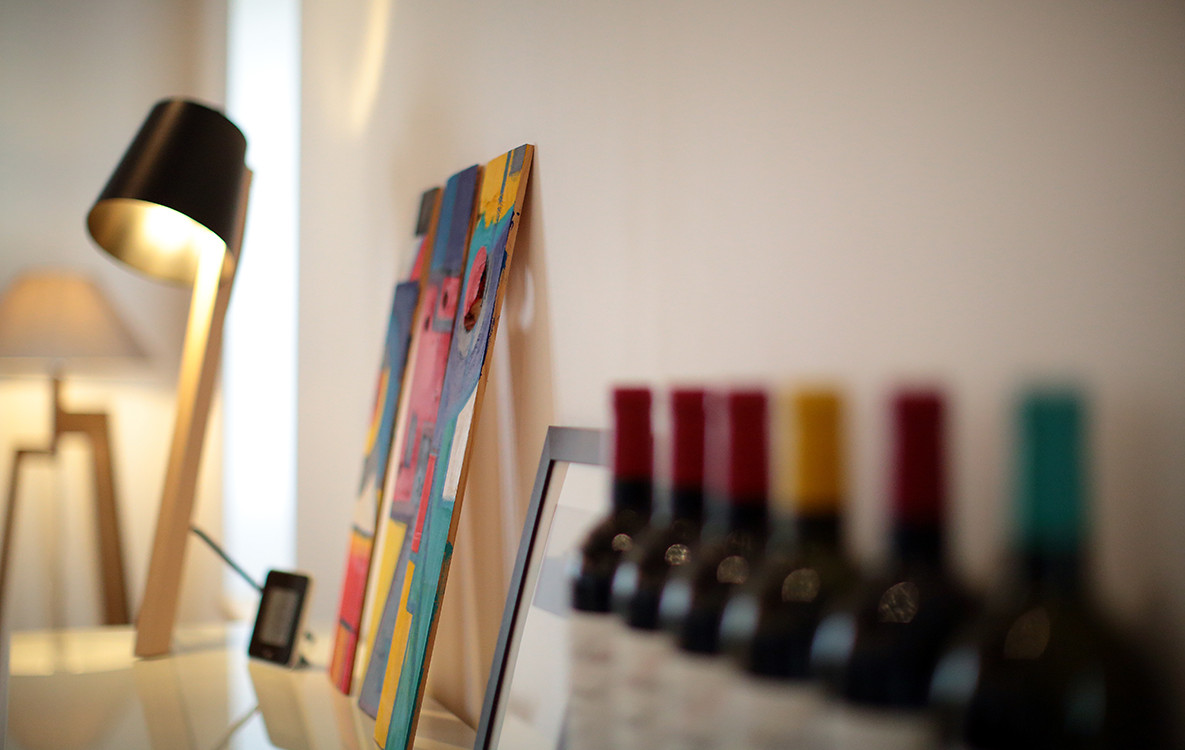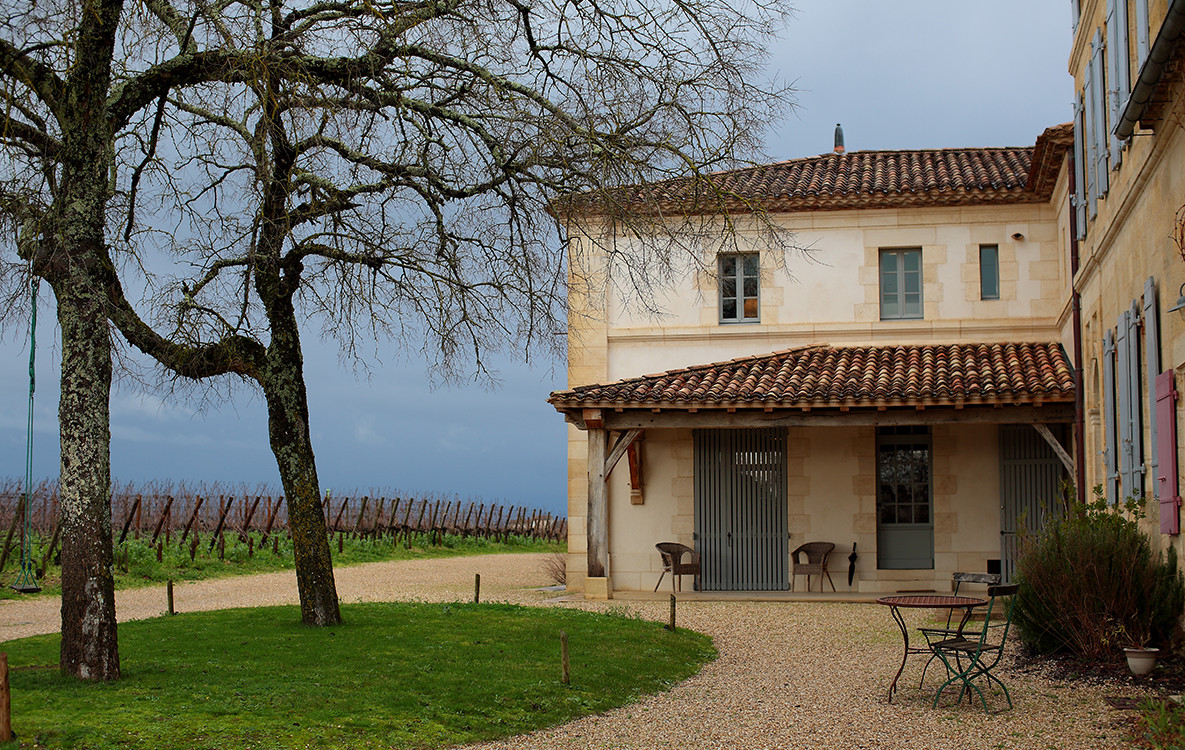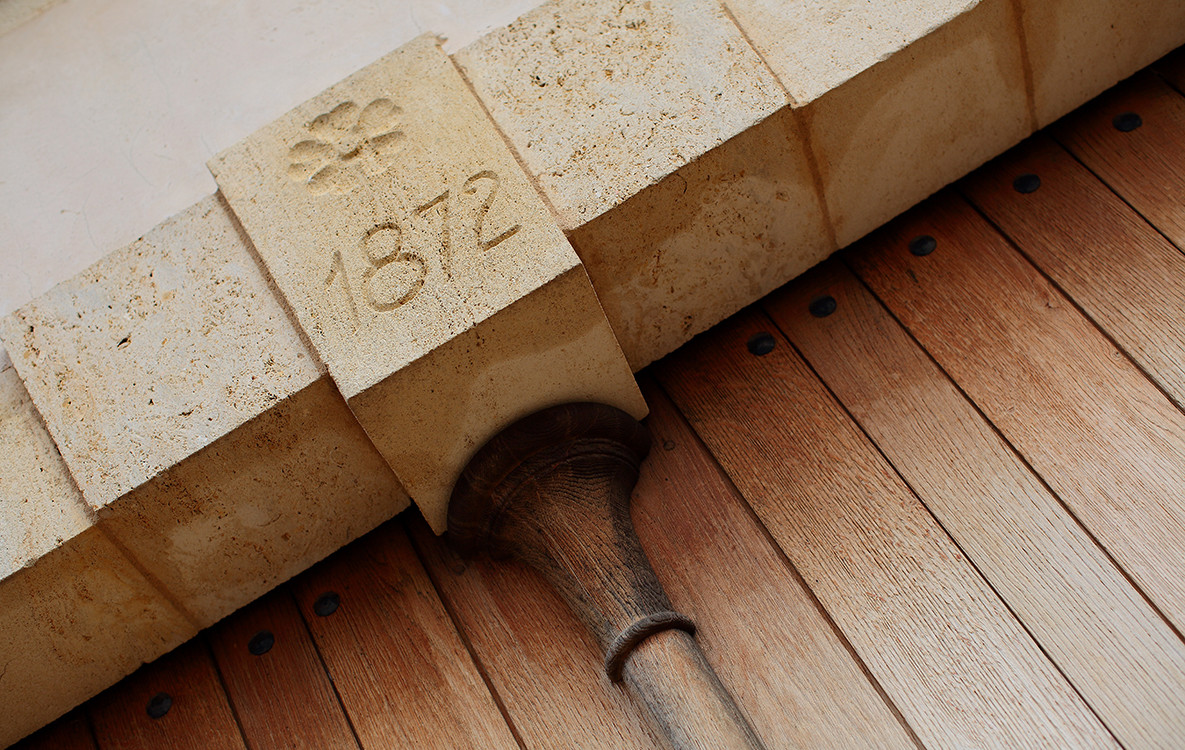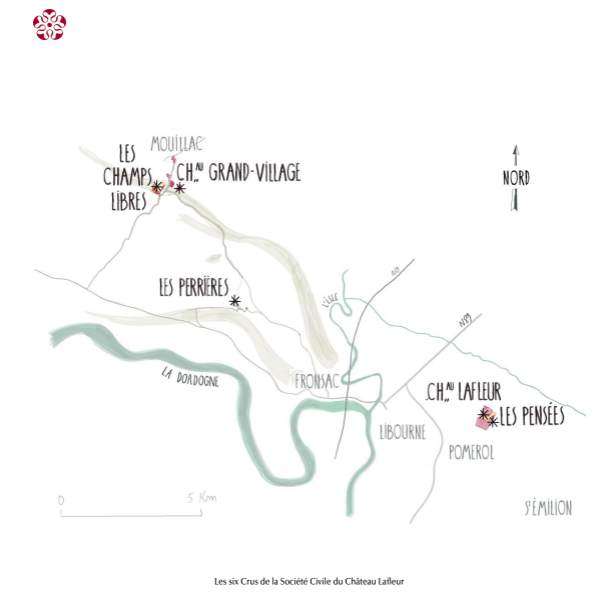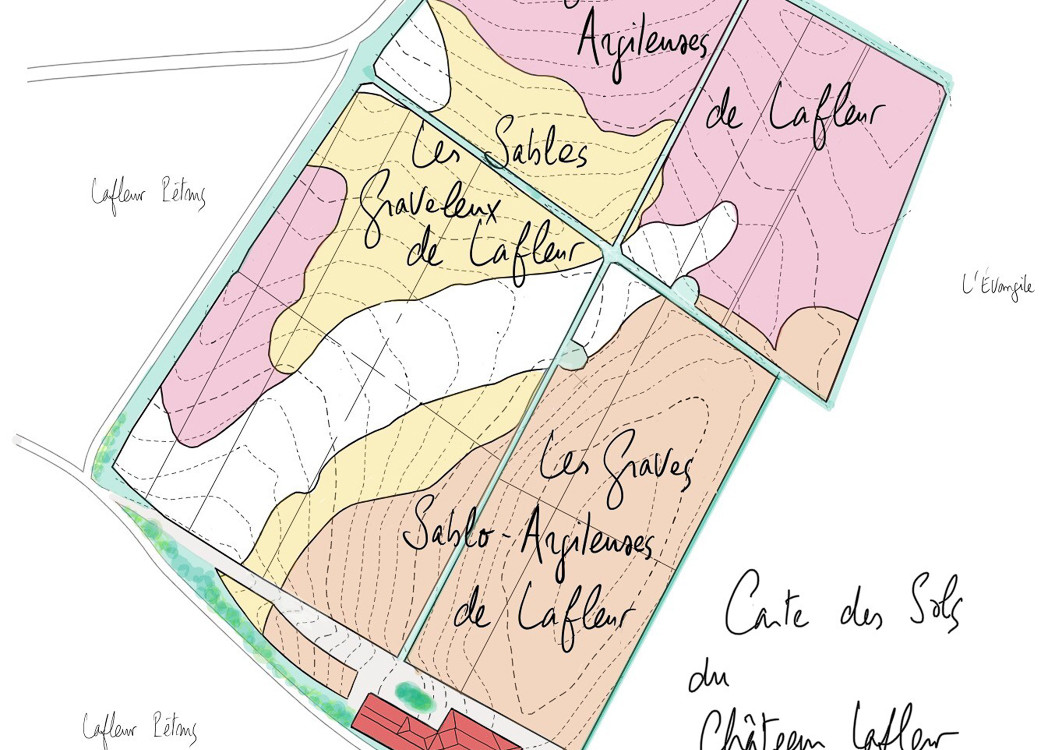Meeting with Baptiste Guinaudeau
“At first, you are surprised by the simplicity of the place. A discreet driveway, a modest stone house with blue shutters, and the vineyard as the horizon line. The rainy and gray day brings its notes of damp earth that align with Pomerol announcing the winter season ahead.” We arrive while Julie, Baptiste, and Omri are having their morning meeting. Standing, coffee in hand, on the terrace facing the vines. The tone is set. Simplicity, smiles, and authenticity. Baptiste warns us that he talks a lot. Indeed, we talked over a glass of Les Champs Libres 2019 for several hours. The lemony, floral notes were in symbiosis with the flowery conversation. As the interview progresses, the wine opens up, its finesse amplifies, its length resonates, and echoes Baptiste’s passionate vision; he expresses being in the right place, and demonstrates his compassionate nature. An interlude that is both grounded and airy.
What is the background to your arrival at Château Lafleur with Julie?
Julie and I arrived at Château Lafleur at the age of 23, just after completing our BTS (French vocational diploma). We started very young, just as my parents did at the age of 24. It was a real opportunity that pushed us to quickly take on challenges.
In 2002, we positioned ourselves to buy the property at a price that was disconnected from any financial reality for us at the time. Working as a family gave us great autonomy and freedom in our choices. Besides, I was born into it, and this is where I have always felt happiest.
What was the pivotal vintage in the history of the property?
The pivotal vintage was 1987. At that time, the benchmark vintage was 1982 (as were 1947, 1971, or 1964), but the worst vintage that they did not want to repeat, the 1984, was also in the cellar. From the spring of 1987, there were a lot of red flags, with a sluggish and very uneven flowering… To avoid repeating the 1984 experience, they had to intervene in the vineyards with green harvesting and sorting, which was contrary to the local spirit of not wasting anything.
That year, Les Pensées de Lafleur was created to help Lafleur position itself where it should be. My parents pushed the message even further by not producing any Grand Vin de Lafleur that vintage.
How did this impact the approach to the following vintages?
The magical trilogy of vintages 1988, 1989, and 1990 followed. Beautiful, various expressions that we also find at Château Grand Village. In 1991, the spring frost hit hard, and this episode prompted all the winemakers (Ausone, Cheval Blanc, Clos Fourtet… all of the same generation) to consider an uneven geometrical viticulture to adapt to the maritime conditions of the region. The horticultural approach to viticulture is essential, especially since we value our production and work on small plots.
1992 marked the début of the Right Bank with this global reflection, which also had its excesses, such as the bonsai period where less was always more, the approach to concentration… The advantage is that we realized we were headed straight for an impasse. The search for harmony brought us back on track with the first soil studies conducted in 1998 with outside experts.
How do you incorporate this scientific data into your daily work?
Soil studies confirm the intuitions that Henri Greloud had previously identified on the 11.11 acres of Château Lafleur. There are three types of soil and a fourth for Les Pensées. The property is divided in two diagonally with a right bank composed of coarse gravel with pebbles and a left bank with finer gravel and some clay, and a very clay-like vein similar to that of Pomerol.
These studies confirm our intuitions. Our approach is like a sandwich made up of two slices of intuition and a filling of convictions confirmed by scientific studies. Although we use scientific data to perform well in the job, the final decision always remains partly a matter of intuition, as we never have enough data to confirm everything.
Although we use scientific data to inform our work, the final decision always remains partly a matter of intuition, as we never have enough data to confirm everything.
What are Lafleur's main strengths?
Our great strength lies in our approach to plot-based wines. We are between Pauillac and Pommard. We operate on a Burgundian scale with a Bordeaux approach where we can allow ourselves a blank page for each vintage with the freedom to play around with the selection.
How do you choose to handle each vintage?
We have a precise idea of where we are going a few minutes before harvesting the first grapes. The style of the vintage is determined throughout the months in the vineyard. At the beginning of February, we already have an idea and we build this image of the vintage during the winemaking stages. We base our daily decisions on what we tasted the previous day.
What are your sources of inspiration as a team manager?
People inspire me on a daily basis. They are the key to the biggest challenges we face. I like to use the parallel of sailing where we aim for a point of arrival with a route full of unexpected events and decisions made on intuition and instinct. It is the same approach at the estate where adaptability and intuition are necessary to be able to make a good decision at the right time while keeping on course and having the reactivity and support of the team. At Lafleur, we are a team of 23 people who are the main driving force.
I hate doubt. Days are already busy enough, so doubt should be reserved for the important questions. For everything else, we need to talk it out in order to find a solution. This requires communication and frankness. Clarity, transparency and trust are essential concepts.
How do you keep the team aligned?
Constant motivation is the best way to stimulate the team. The worst moment is waiting, for example, for the harvest. Furthermore, the strength of the team comes from the diversity of nationalities and personalities. Here, we have a third of people who are not from the wine world and not all of them are here by chance! That’s the most important thing.
What are the core values?
We are a family, we share everything. We love wine. We have strong and diverse characters. Everyone participates throughout the year in the life of the estate, so we have a global view of what is happening. This avoids divisions between the different know-how necessary for the elaboration of the wine. However, to gain expertise, it is evident that certain specializations come with time.
How do you and Julie fit into the team?
Julie and I could be in the vineyard and cellar every day, as that is where we love to be, but we also have the role of being the driving force of the team. This has allowed my parents to take a step back and do things they didn’t have time for before, such as handle public relations, labels, and work on our distribution to make it consistent with our values. These are projects that have occupied some members of the team.
As for me, I oversee everything. I watch over everyone, and my goal is to find someone better than me on every issue, whether internal or external.
What are the big topics of the moment?
We are experiencing a golden period where great vintages are succeeding one another. We are reaching a turning point where what made a great vintage in Bordeaux is being challenged. Before, there were three major climates. Either a solar climate, with a hot and dry climate like 1989, 2005, or 2015. Or a classic “Bordeaux” climate marked by an oceanic influence with more balanced wines like 1986, 1988, 2014, or 2012. Then, there were vintages with extreme climates, very humid or very hot. Before, we would have one extreme vintage per decade, but in recent years, they have been happening more frequently.
2016 marks a turning point. It is a mixed vintage with distinct sequences and rapid shifts from one extreme to another, which we experienced in 2018 and 2020.
We are experiencing a golden period where great vintages are succeeding one another. We are reaching a turning point where what made a great vintage in Bordeaux is being challenged.
What state of mind are you in?
We are blessed! We know how to steer our teams in the right direction to maintain positive momentum. Julie and I have also reached a point in our lives where we have been making wine for 20 years. We’ve made mistakes, we’ve experienced things, and we feel more at ease now. That helps a lot. Everything is good. But the question is, how do we make this last? How do we pass on all of our knowledge? How will we be able to adapt our viticulture to the future, which will be in a different context? Even though we’d like to stay proactive, we find that things are changing really fast.
What do you primarily look for in wines?
Purity, brightness, brilliance, and transparency in the structure. Density through the velvetiness of tannins rather than power, and length and persistence. Our interest lies in what happens in the minutes after tasting rather than the immediacy of the flavour or the mid-palate. All of this is achieved through vineyard work. We work with small plots. The Pensées plot is only 1.7 acres, so our challenge is to manage these small volumes without extracting too much, as we don’t have the volume to balance it out. We are constantly in search of finesse. We blend the grapes very early with precise harvest choices to obtain the necessary volume. We work on the individual plots or even within the plots in the vineyard, but in the cellar, we don’t try to isolate our harvest into multiple lots. We believe that early blending makes the best wine. The vine’s maturity, sequences, and growth cycles are more easily identifiable in the vineyard to achieve this search for harmony, unity, and brilliance.
How do you manage to find a balance between technique and intuition?
The starting point is that we love what we do. Wine is organic, it’s not just science. We can all detect important elements in the wine using the same tools: a mouth and a brain. Once the wine has been tasted, we can then decide which vinification path to go down. Then, there is chiefly a notion of continuity as well as technicality. We all like comfort but it’s in discomfort that we develop the most. In the beginning, we financed a project where we clearly didn’t have the means. Today, we are facing the discomfort of climate change… Ultimately, these uncomfortable situations stimulate us.
In this subtle search for balance to last, we must always be wary of trends and miracle solutions. We must focus on adapting to what is happening in real time and surrounding ourselves with the right people. Since 2008, all decisions have been made between Julie and myself. Our great fortune lies in the fact that we have always been surrounded by the right people while having carte blanche from my parents. For me, there are no complicated decisions, the worst thing is not making any decisions.
What do you like to convey to the drinker?
Have fun! Trust your own palate! Use this personal tasting experience to continue your journey. Realise that the tasting experience is not about the immediacy, but the length. The finish really makes the difference between a good wine and a great wine. Our core value focuses on that subtlety which gives our wine a different dimension. That’s our aim.
Stay curious! Novices are sometimes the most interesting people, because they are carried away by their emotions and do not give a technical or preconceived point of view.
How does the reorganisation of your distribution align with your work philosophy?
Distribution with the right partners, ensures we value all the investments and efforts we make at the property. It is in this spirit that we have adopted a mixed system with the en primeur system as well as vintages ready to drink. We continue to sell en primeur even though the exercise today is based on a tasting done at a stage where it is difficult to imagine how the wine will evolve in bottle. The en primeur release is a step in the vintage just as the four seasons are. It is also an opportunity to communicate with the players at the heart of the en primeur system. The sale of bottled wines is another step and we also make sure we maintain this activity in addition to en primeur.
What does it mean to you that Vignobles et Châteaux is one of the ambassadors of Château Lafleur?
As a wine merchant, you are the final and essential link for us. You complete the loop without which we would not have distribution and deconstruction of people’s preconceptions of wines of Bordeaux. Creating an emotion, a memory, is the gateway to great wines of Bordeaux.
Portrait
A book: Le Monde (the newspaper), I am a big reader of the press
A music group: Beastie Boys
A movie: Amores Perros by Iñárritu
A smell: wet gravel after the rain
A vintage: 2016, the turning point
A memorable bottle: Echezeaux Grand Cru 2002 by Emmanuel Rouget
A dish: scrambled eggs with truffles
A destination: Australia, Victoria
A mantra: move, move, move
A perfect Sunday: not much sleep and having fun! We spend a lot of time on horseback and in the water, for example, surfing.
Wines related to the article :
Some milestones:
1650: Jacques Verdery establishes Château Grand Village.
1872: Henri Greloud, ancestor of Baptiste Guinaudeau, buys a 4.58-hectare plot and creates Château Lafleur.
1920: André Robin, Henri’s great-nephew and a genetics enthusiast, replants all of Lafleur with high-quality vines, including Bouchet.
1944: Thérèse and Marie Robin inherit the estate, and Lafleur is preserved for 40 years through no choice of their own.
1985: Sylvie and Jacques Guinaudeau are hired as farmers at the Château after one of the sisters dies.
1987: The second wine, Les Pensées de Lafleur, is created, which later becomes Les Pensées, a separate Cru on the sandy-gravelly clay of the Lafleur vineyard.
1990: Sylvie and Jacques launch Château Grand Village Blanc.
2000: Julie and Baptiste Guinaudeau arrive at the estate.
2002: The Guinaudeau family has the opportunity to buy the property.
2013: The first vintage of the Cru Les Champs Libres is produced.
2018: The Cru Les Perrières is launched.
Interview by Marie-Pierre Dardouillet, Cépages communication for Vignobles et Châteaux
Photos : Cyril Bernard
